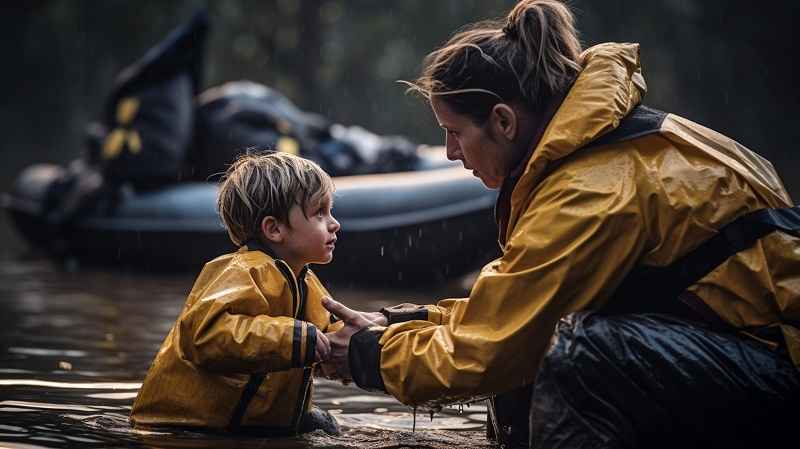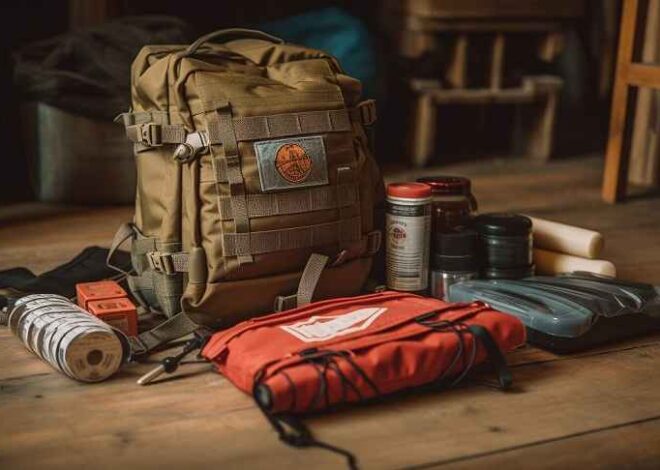
Family Safety First: Teaching Kids About Preparing for Severe Weather
When dark clouds begin to gather and the winds start to howl, it’s not just nature putting on a dramatic show; it’s a reminder that severe weather can strike when we least expect it. As parents, our instinct is to shield our children from fear while also equipping them with the knowledge they need to stay safe. But how do we turn potentially frightening scenarios into teachable moments? Welcome to “Family Safety First,” where we explore creative and engaging ways to educate your kids about preparing for severe weather! Join us as we unravel fun activities, essential tips, and reassuring strategies that will empower your little ones—transforming them from passive observers into proactive safety champions ready to face whatever Mother Nature throws their way. Let’s dive in and make preparedness a family adventure!
Introduction to Severe Weather and its Impact on Families
Severe weather can strike at any moment, leaving families scrambling for safety. From tornadoes to hurricanes, the unpredictability of nature poses real risks that we cannot ignore. It’s crucial to prepare ourselves and our children for these challenges. But how do you even begin teaching kids about severe weather preparation? This guide will walk you through essential steps and fun methods to ensure your family is ready when disaster strikes. After all, knowledge is power—especially when it comes to keeping our loved ones safe. Let’s dive into making severe weather preparedness a family affair!
Why it is Important to Teach Kids about Severe Weather Preparedness
Teaching kids about severe weather preparedness is essential for their safety. Children often feel anxious during storms or disasters, and understanding what to expect can help alleviate that fear.
When children know how to respond in emergencies, they become more confident. This empowerment allows them to take action when it matters most.
Moreover, instilling these lessons early creates lifelong habits of awareness and caution. Kids who learn about severe weather are likely to share this knowledge with their peers.
Preparedness also fosters family bonding as you work together on plans and practice drills. It’s a wonderful opportunity for open discussions about safety without instilling unnecessary fear.
By equipping young minds with the right tools, you’re not just protecting them; you’re nurturing responsible citizens ready to face challenges ahead.
Steps to Take Before Severe Weather Strikes:
Creating a Family Emergency Plan is essential. Gather your family and discuss what to do in various weather scenarios. Assign roles so everyone knows their responsibilities during an emergency.
Next, stocking up on supplies can make all the difference. Ensure you have essentials like water, non-perishable food, flashlights, batteries, and a first-aid kit ready at home. Check these items regularly to keep them fresh and functional.
Knowing Your Local Evacuation Routes is crucial for safety. Familiarize yourself with multiple paths in case of evacuation orders. It’s wise to practice driving those routes together as a family when conditions are calm.
These steps not only prepare your household but also instill confidence in your children about facing severe weather events head-on.
-
Creating a Family Emergency Plan
Creating a family emergency plan is essential for ensuring everyone knows what to do during severe weather events. Start by gathering the whole family together. Discuss potential scenarios like tornadoes or floods and how each person can contribute.
Designate specific meeting points inside and outside your home. This way, if you get separated, everyone has a clear idea of where to go. Make sure these locations are easily accessible and familiar to all family members.
Assign roles based on age and abilities. Younger kids can help gather supplies while older siblings may be in charge of communication with relatives.
Practicing your plan regularly helps reinforce it in their minds. Regular drills will make them feel more comfortable when real emergencies arise, turning anxiety into confidence when it matters most.
-
Stocking up on Supplies
When preparing for severe weather, having the right supplies can make all the difference. Start by assembling a well-stocked emergency kit. Include essentials like water, non-perishable food, and first-aid items.
Don’t forget about batteries and flashlights. Power outages can hit unexpectedly during storms. Keeping extra blankets on hand ensures everyone stays warm if temperatures drop.
Involve your kids in this process to spark their interest. Let them help choose snacks or pack their favorite toys into the emergency bag. This involvement makes them feel empowered and prepared.
Regularly check expiration dates on food or medicine in your supplies. Rotate items as needed to keep everything fresh and usable when it matters most.
Remember that each family’s needs are unique, so tailor your supply list accordingly to ensure you have what works best for yours.
-
Knowing Your Local Evacuation Routes
Knowing your local evacuation routes is crucial for family safety during severe weather events. It’s not just about having a plan—it’s about being prepared to take action quickly.
Start by researching the designated routes in your area. Local government websites often provide maps and updates on these paths, especially ahead of storm season.
Drive those routes with your kids so they become familiar with them. This hands-on experience can ease anxiety when the time comes to evacuate.
Discuss potential obstacles—like traffic or road closures—that may occur during an emergency. Encourage open conversations about what they would do if faced with unexpected situations on the road.
Reinforce this knowledge through practice runs as part of your preparedness drills. Familiarity breeds confidence, making it easier for everyone to respond calmly and effectively when needed most.
Teaching Kids about Different Types of Severe Weather:
Understanding different types of severe weather is essential for kids. Knowledge empowers them to stay safe during unexpected situations.
Tornadoes can appear suddenly. Teach children how to identify the signs, such as dark clouds and a loud roar. Discuss the importance of seeking shelter immediately.
Hurricanes bring strong winds and heavy rains. Explain how they form and what precautions families should take when one approaches, including evacuation plans.
Thunderstorms can be frightening but are common. Help your kids understand lightning safety tips, like staying indoors until the storm passes.
Floods often result from heavy rain or storms. Show children how to recognize flood warnings and discuss why it’s vital not to play in flooded areas.
Using relatable examples makes these concepts clear for young minds. Engaging conversations about severe weather will help solidify their understanding while keeping safety at the forefront of their thoughts.
-
Tornadoes
Tornadoes are one of nature’s most powerful and unpredictable storms. They can form quickly, giving little time to react. Understanding their characteristics is vital for safety.
These swirling columns of air extend from thunderstorms to the ground. Their raw energy can cause immense destruction in just moments. The sound they make is often described as a freight train roaring past.
It’s crucial for kids to recognize tornado warnings and alerts. Explain what takes place during severe weather watches versus warnings. Encourage them to stay calm and follow your family’s emergency plan when they hear those alerts.
Teach children about safe spots in your home, like basements or interior rooms without windows. Practice going there together so it feels less daunting if an actual tornado strikes. Knowledge builds confidence, making them more prepared should the need arise.
-
Hurricanes
Hurricanes are powerful storms that form over warm ocean waters. Their strong winds can cause catastrophic damage to coastal communities. Understanding the nature of hurricanes is crucial for safety.
When a hurricane approaches, it’s important to stay informed through weather updates and alerts. This allows families to prepare and take necessary precautions in advance.
Kids should learn about the different categories of hurricanes, which indicate their strength and potential impact. The higher the category, the more dangerous it becomes.
Discussing evacuation plans is essential too. Children need to know when it’s time to leave home and where they will go if a storm threatens their area.
Using visual aids can make these concepts clearer for younger kids. Interactive maps showing hurricane paths help them grasp how these storms travel and affect various regions.
-
Thunderstorms
Thunderstorms can roll in suddenly, bringing with them powerful winds, heavy rain, and lightning. These storms are a common occurrence across many regions. Understanding their nature is crucial for kids.
First and foremost, it’s essential to recognize the signs of an approaching thunderstorm. Darkening skies and distant rumbles of thunder signal that it’s time to take action.
Once indoors, safety should be a priority. Teach children to stay away from windows and doors during a storm. Lightning strikes pose serious risks; explain how they can affect both people and structures.
Encourage kids to listen for weather updates on local channels or apps. This helps them understand when it’s safe to venture outside again after the storm has passed.
By familiarizing themselves with thunderstorms’ characteristics and dangers, children become more confident in handling these unpredictable weather events responsibly.
-
Floods
Floods can strike unexpectedly, often with little warning. These natural disasters occur when rivers overflow or heavy rainfall saturates the ground beyond its capacity. They can happen anywhere, affecting communities large and small.
Teach children to recognize flood warnings and signs. Discuss how water levels rise rapidly, making it essential to stay informed through weather updates.
Children should understand the dangers of rising water. Explain that even a few inches can sweep them away. Emphasizing safety is crucial; remind them never to play in flooded areas.
Creating a safe space at home during a flood involves knowing where to go if evacuation becomes necessary. Help kids identify higher ground nearby where they could seek shelter if needed.
Encourage your family to practice their response plan regularly so everyone feels prepared when floods threaten their area. This knowledge empowers children and gives them confidence during an emergency situation.
Fun Ways to Educate Kids about Severe Weather Preparedness:
Educating kids about severe weather preparedness can be both fun and engaging. One effective method is through role-playing games. Children love to act out scenarios, so why not create a mock emergency situation? This allows them to practice their responses in a safe environment.
Arts and crafts activities can also make learning enjoyable. Create colorful posters that illustrate what to do during different types of severe weather. Kids will take pride in displaying their artwork while reinforcing essential information.
Another engaging approach is scavenger hunts for emergency supplies. Hide items like flashlights or first-aid kits around the house and let your children search for them. This activity teaches them where supplies are located while adding an element of excitement.
Incorporating these playful techniques ensures kids absorb vital safety lessons without feeling overwhelmed by the seriousness of the topic.
-
Role-playing games
Role-playing games offer a playful way to teach kids about severe weather preparation. By creating scenarios, children can immerse themselves in various emergencies. This hands-on approach makes learning engaging.
Consider acting out a tornado drill. One child can play the role of a weather broadcaster, while others respond by finding shelter. This encourages teamwork and problem-solving skills.
You might also set up situations where kids must gather supplies quickly. Each player takes on different family roles—parent, sibling, pet—and learns what each member needs during an emergency.
These activities not only build knowledge but also help reduce anxiety around severe weather events. Kids learn that being prepared is both important and fun! Plus, they’ll remember their experiences more vividly than just reading from a book or watching videos.
-
Arts and crafts activities
Arts and crafts can be a fantastic way to engage kids while teaching them about severe weather preparation. It transforms learning into something fun and interactive.
You might start with making colorful emergency kits. Use old shoeboxes to decorate with art supplies, labeling each box for specific items like first aid or snacks. This hands-on activity reinforces what should go inside those kits.
Another idea is creating a weather wheel. Kids can design their own wheels featuring different types of severe weather, such as tornadoes and hurricanes. Turning the wheel can spark discussions about safety measures tied to each type.
Consider crafting storm safety posters together. Encourage creativity by using bright colors and bold letters to highlight key tips—like “Stay Indoors During a Thunderstorm.” These visual reminders will serve as excellent references when storms approach.
Engaging in these creative projects helps solidify important lessons through playfulness, ensuring your children understand the importance of preparedness.
-
Scavenger hunts for emergency supplies
Scavenger hunts are an exciting way to engage kids in severe weather preparation. They turn a serious topic into a fun and interactive experience.
Start by creating a list of essential emergency supplies, such as flashlights, first aid kits, non-perishable food items, and water bottles. Hide these items around your home or yard.
Set up the scavenger hunt with clues that lead to each supply. This adds an element of adventure while teaching children about what they need during emergencies.
As they find each item, discuss its importance in keeping the family safe during severe weather events. Encourage teamwork and problem-solving among siblings or friends for added enjoyment.
By blending play with learning, you can instill valuable knowledge about preparedness without overwhelming them. Kids will remember this hands-on approach much better than dry lectures on safety protocols!
Helpful Resources for Teaching Kids about Severe Weather Preparedness:
Books can be a fantastic resource for teaching kids about severe weather. Look for engaging stories that feature characters facing storms or natural disasters. These narratives help children relate to the concepts while learning valuable lessons.
Movies and documentaries also serve as great educational tools. They often depict extreme weather events, illustrating their impact in an entertaining way. Choose age-appropriate films that not only captivate but inform young minds.
Consider interactive online resources too! Websites focused on weather education offer games, quizzes, and videos designed specifically for kids. Such platforms make learning fun while reinforcing important safety messages.
Don’t forget local community programs either! Many fire departments or emergency management offices provide workshops tailored for families. Participating in these sessions can strengthen bonds while empowering children with knowledge about severe weather preparedness.
-
Books and movies
Books and movies can be valuable tools for educating kids about severe weather preparedness. They provide engaging stories that illustrate the importance of being prepared while sparking children’s imaginations.
Look for age-appropriate books that feature characters facing various weather challenges. Titles like “Tornado Alert” by Franklyn M. Branley or “The Magic School Bus: Inside a Hurricane” are great starting points. These narratives can help children understand potential dangers in a relatable context.
Additionally, watch family-friendly films that depict severe weather events, discussing how characters respond to emergencies. Movies such as “Twister” or animated features like “Cloudy with a Chance of Meatballs” offer entertainment while also opening up discussions on safety measures.
Utilizing these resources encourages dialogue and reinforces lessons learned during activities and planning sessions at home. The more familiar kids become with these concepts, the more confident they will feel when faced with real-life situations involving severe weather preparation.


